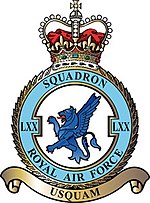No. 70 Squadron RFC
| No. LXX Squadron RAF | |
|---|---|

|
|
| Active |
|
| Country |
|
| Branch |
|
| Type | Flying squadron |
| Role | Strategic and tactical air transport |
| Part of | No. 2 Group RAF |
| Home station | RAF Brize Norton |
| Nickname(s) |
Usquam (Latin for Anywhwere) |
| Aircraft | Airbus A400M Atlas C1 |
| Battle honours |
|
| Insignia | |
| Squadron badge heraldry | A demi-wing lion erased. Developed from an unofficial winged lion badge probably derived from the squadron's long dependence on the Napier Lion engine during the 1920s. |
The squadron was formed on 22 April 1916 at Farnborough, and was equipped with the Sopwith 1½ Strutter. The squadron was posted to France, and in 1917 re-equipped with Sopwith Camels.
During World War I, the squadron claimed 287 victories, and had as members nineteen aces, including Frank Granger Quigley, John Todd, Frank Hobson, Oscar Heron, Frank Gorringe, Walter M. Carlaw, George Robert Howsam, Clive Franklyn Collett, Alfred Michael Koch, Kenneth Bowman Watson, Noel Webb, Edward Gribben, and Frederic Laurence.
The squadron briefly disbanded in January 1920, reforming nine days later at Heliopolis, Egypt, via the renumbering of No. 58 Squadron. The squadron was now a bomber-transport unit operating the Vickers Vimy bomber. After transferring to Hinaidi, Iraq in December 1921, the squadron was re-equipped with Vickers Vernon’s and subsequently by Vickers Victoria in 1926. In addition to providing heavy transport facilities to both air and ground units they were used as air ambulances and were responsible for maintaining the Cairo-Baghdad airmail route. The squadron was commanded by Group Captain Eric Murray DSO MC. In 1929, he flew the first route to the Cape on behalf of Imperial Airways who were seeking routes for the civil flights.
...
Wikipedia
